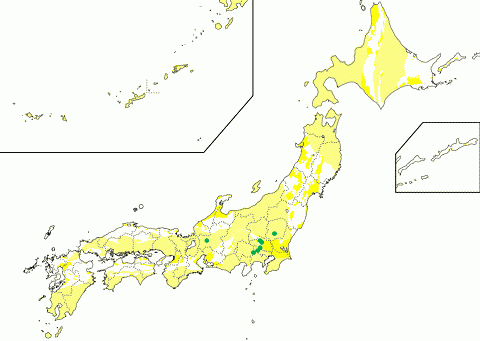Diagenesis
Chemical Process (Metamorphism, Solid-phase growth) - Burial Metamorphism (Low-P, Low-T)
Required Geological Setting
Neogene and Quaternary sediments, Paleogene and older sediments, Accretionary complexes
Occurrence
Minerals formed in sediments subjected to diagenetic processes by burying. Diagenesis is composed of the physical consolidation process and the chemical cementation and alteration processes. In the physical consolidation process, interstitial water is squeezed out by load pressure and grains of seidments are rearranged. In the chemical cementation and alteration process, minerals in sediments are dehydrated and grains of sediments are cemented by mineral deposition from interstitial water. In the late stage of diagenesis, clay minerals are formed by elevated pressure and/or temperature. This reaction can be considered as a part of regional metamorphism, thus diagenesis is contineous with regional metamorphism. The boundary of diagenesis and metamorphism is defined by illite crystallinity 0.42 or vitrinite reflectance 2.0, which corresponds to 200 degree in temperature. Based on this definition, low-temperature zeolite facies and high-temperature zeolite facies are included in diagenesis. Diagenesis may include the submarine weathering, in which clay mineral are formed by reaction with seawater in the ocean floor deposition process of sediments. Water for diagenesis is interstitial water of sediments and water/rock ratio is less than ten times. It means that diagenetic minerals are formed by a closed reaction system. On the other hand, water for hydrothermal alteration such as cristobalite zone, smectite zone and stilbite-mordenite zone is meteoric and/or magmatic circulating water, and water/rock ratio is more than a few tens times. It means that hydrothermal minerals are formed by an open reaction system. Mineral reactions of diagenesis are classified into two stages: the early diagenesis less than 70 degree in temperature and the late diagenesis more than 70 degree. In the early diagenesis, clay minerals are formed as follows; Kaolinite is formed in the lacustrine and fluvial sediments in regions that have a large amount of rainfall. Smectite is formed in the lacustrine and fluvial sediments in regions that have a small amount of rainfall. Smectite, vermiculite, and kaoline minerals are formed in the marine sediments. Saponite and/or celadonite are formed in the Mg and Fe-rich sediments such as ocean floor basalts. In the late diagenesis, illite and/or chlorite are formed from smectite originated from the early diagenesis. Polytypes of illite change from 1Md via 1M to 2M1 along progress of diagenesis. Corrensite is formed from Fe-rich smectite or Fe-rich saponite at 60-70 degree, and corrensite changes to chlorite in the course of time.

Distributio of sediments subjected to diagenetic process described in this site. Yellow zones indicate the distribution of Quaternary, Neogene, Paleogene sediments and accretionary complexes.
Mineral Assemblages (Early diagenesis)
Opal-A, Smectite, Saponite, Kaolinite, Celadonite
Mineral Assemblages (Late diagenesis)
Illite, Chlorite, Corrensite
Localities
- Kanuma (Weathered pumice, Imogilite)
- Bushi (Trace fossil, Siderite)
- Kowada (Nodule, Siderite)
- Nohori (Trace fossil, Vivianite)
Related Occurrences
- Albite-Epidote-hornfels facies
- Hornblende-hornfels facies
- Pyroxene-hornfels facies
- Sanidinite-hornfels facies